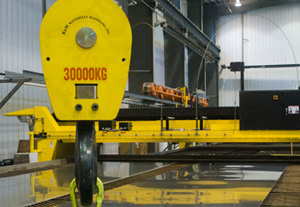
The variations of plasma cutting have been common methods used in the profile cutting industry for numerous years. Since World War II, plasma cutting has been employed as the main approach to metal cutting, due to the many benefits it produces for companies. For instance, plasma cutters are considered the ideal method for metal profiling as the machines are able to work with the widest variety of metals.
While there are several different types of plasma cutters, all use the same process of employing electrochemistry.
Plasma cutters operate under the notion that as a gas is heated, its electrons and ions begin quickly moving. When they touch one another, an intense amount of energy is created, producing plasma. When the plasma is traveling through a narrow opening, it is so hot, pressurized, and is moving so quickly, that it is able to cut through many different types of alloys.
At the centre of a plasma head is a passage with a negatively charged electrode. The negative electrode is powered when the nozzle meets the workpiece, creating a spark, known as a plasma arc or electric arc, that heats the gas as it passes through the channel, changing the gas into plasma.
The plasma of cutting devices can reach up to 25,000 degrees Celsius (or 45,000 degrees Fahrenheit) and flow as quickly as 20,000 feet per second.
Plasma cutters come in many different forms. There are portable and stagnant machines, as well as plasma gouging devices that are better suited for corrections and improving the strength of the materials cut. Another option of plasma cutting are computer numerical control machines. The latter option is commonly referred to as CNC plasma cutters.
CNC plasma cutters are sometimes known as LCD cutters. This variation of plasma cutting is thought of as a more valuable device as it cuts metal with much greater precision and detail.
CNC plasma cutting devices contain a hard disk, just like the hard disk found in a personal computer. The hard disk secures accuracy and precision of cuts as its purpose is to store dimensions and specifications of the desired outcome. These machines are very adaptable and have gained attention mostly through its employment within manufacturing and construction industries, and more obviously with metal cutting and processing companies.
CNC cutters are available in several different forms and sizes. Types of CNC cutting devices include:
The cut results of the latter two types are similar to those produced using a laser cutter, in relation to performance and accuracy.
There are many benefits to using an LCD plasma cutter as opposed to a manual plasma cutter. The advantages are:
-
More precision an accuracy
-
Better suited for complex cuts like multi-axis cuts and 3D cuts
-
Easier to use
-
Due to ease of operation, it has a higher production rate, making companies more efficient
-
Minimal to no errors produced
-
Due to minimal errors, secondary operations are avoided
Plasma cutters have been essential and common within the metal cutting industry, and by extension, all its affected industries such as construction, automotive, and medical equipment manufacturing. As technology advances, production rates increase, consequentially influencing the demands and expectations for metal cutting. CNC plasma devices are able to produce results that meet today's expectations and demands for production.